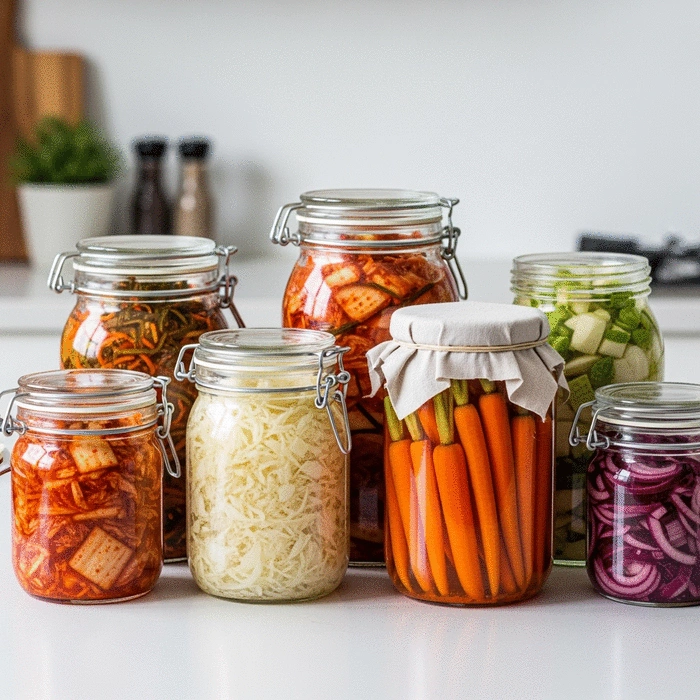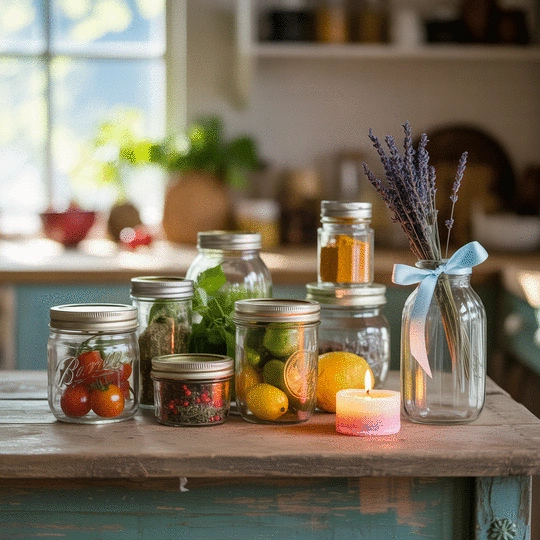Fermenting in Glass Jars

Posted on: 2025-10-19
By: Clara Penrose
What if you could elevate your culinary experience while embracing sustainability? The world of fermentation using glass jars offers just that opportunity. From flavor preservation to eco-friendly practices, this guide unveils the essential techniques and choices that can transform your kitchen into a hub of creativity.
What You Will Learn
- Glass jars are non-reactive and eco-friendly, making them ideal for safe fermentation.
- Using clear glass allows for easy monitoring of the fermentation process, enhancing your experience.
- Explore different types of jars, such as Mason and Fido jars, each offering unique benefits for specific fermentation needs.
- Master the use of airlocks and fermentation lids to create optimal anaerobic conditions, preventing contamination.
- Innovative techniques like one-way valves simplify gas management during fermentation, reducing the hassle associated with traditional methods.
- Join the fermentation community through workshops and online resources to enhance your skills and creativity.
Glass Jars for Fermentation: Benefits and Types
This visual highlights the key benefits of using glass jars for fermentation and the popular types available.
Benefits of Glass Jars
- ✓ Flavor Preservation: Maintains pure and vibrant flavors.
- ✓ Safety: Non-reactive, reducing contamination risk.
- ✓ Visibility: Allows easy monitoring of fermentation.
- ✓ Eco-Friendly: Reusable and sustainable.
Types of Jars for Fermentation
- • Mason Jars: Classic, widely available, various sizes.
- • Fido Jars: Airtight seals, clamp lids for controlled environment.
- • Flip-Top Jars: Gasket seal, easy access, tight seal.
Essential Equipment
- • Airlocks: Release CO2, prevent O2 entry.
- • Fermentation Lids: Built-in airlocks, easy to use.
- • One-Way Valves: Gas release without air entry.
Gas Management Techniques
- • Burping Jars: Manually releasing gas periodically.
- • One-Way Valves: Automatic gas release, safer & simpler.
Understanding Advanced Fermenting Techniques in Glass Jars
As I dive deeper into the world of fermenting, I can't help but emphasize the magic of using glass jars. These versatile containers not only serve as eco-friendly storage solutions but also enhance the fermentation process itself. When it comes to preserving flavors while ensuring safety, glass jars stand out for a variety of reasons. They are non-reactive, meaning they won’t leach harmful substances into your food, and their transparency allows you to monitor the fermentation process easily.
Furthermore, glass jars create a visual appeal that draws you in, making the fermentation process feel more engaging. You can see the vibrant colors of your fermenting vegetables, which adds an artistic touch to your kitchen. With the right techniques, using glass jars can elevate your fermentation game and inspire you to explore new flavors! For more insights into sustainable kitchen practices, check out our guide on an eco-friendly kitchen with glass jars.

The Benefits of Using Glass Jars for Fermentation
- Flavor Preservation: Glass jars maintain the integrity of your ingredients, ensuring that the flavors remain pure and vibrant.
- Safety: They don’t react with the contents, unlike some plastics or metals, reducing the risk of contamination.
- Visibility: The clear glass allows for easy monitoring during the fermentation process, so you can catch any issues early.
- Eco-Friendly: They are reusable and sustainable, aligning perfectly with my mission at Glass Jar Hub.
These benefits solidify why I prefer glass jars for fermenting. It’s about more than just practicality; it’s about enhancing your culinary experience and embracing sustainability. Whether you're a seasoned fermenter or just starting out, remember that each jar is a step toward a more flavorful and eco-conscious lifestyle!
Choosing the Right Glass Jars and Lids for Fermentation
Now that we’ve established the benefits, let’s discuss the different types of glass jars you can use for fermentation. Choosing the right jar is crucial for successful fermenting. There are several options available, each with unique features that may suit your needs.
- Mason Jars: These are the classic choice for fermenting. They are widely available and come in various sizes, making them perfect for small batches.
- Fido Jars: With their airtight seals and clamp lids, Fido jars are excellent for creating a controlled environment during fermentation.
- Flip-Top Jars: These jars often come with a gasket seal, allowing for easy access while still ensuring a tight seal to prevent contamination.
When selecting a lid, consider choices like airlocks or fermentation lids, which allow gas to escape while keeping out oxygen. These tools are essential for maintaining a safe fermenting environment. In my experience, using the right glass jar and lid makes a world of difference in achieving successful and delicious fermented foods! You can also discover more about selecting glass jars for canning, which shares many similarities with fermentation jar selection.
Essential Equipment for Enhancing Flavor and Safety
The Role of Airlocks and Fermentation Lids
Airlocks and fermentation lids play a critical role in the fermentation process. They help manage gas release, preventing pressure buildup while keeping harmful bacteria at bay. An airlock allows carbon dioxide to escape while preventing oxygen from entering, which is key to creating the ideal anaerobic conditions for fermentation.
Some popular options include water-seal crocks, which are fantastic for larger batches, and reusable fermentation lids designed for standard jars. These lids often come with built-in airlocks, making them easy to use and perfect for beginners!
Innovative Techniques for Managing Fermentation Gases
When it comes to managing fermentation gases, there are a couple of methods to consider. You may have heard of “burping” jars, where you manually release gas build-up. While this method works, it requires regular monitoring and can be a bit messy.
- Burping Jars: This involves loosening the lid periodically to release gas. It’s simple but requires diligence.
- One-Way Valves: These lids allow gas to escape without letting air in, which enhances safety and makes fermentation more straightforward.
In my experience, using one-way valves significantly reduces the hassle of burping and allows me to focus on flavor development instead. Choosing the right method can make the fermentation process smoother and yield tastier results!

Pro Tip
For optimal fermentation results, consider using a combination of glass jars with different lid types. This allows you to experiment with various fermentation techniques while ensuring safety and flavor preservation. Pairing Fido jars with airlocks can create a controlled environment, while traditional Mason jars can be perfect for smaller batches. Each method can yield unique flavors, so don’t hesitate to explore!
Encouragement to Experiment with Advanced Fermenting Techniques
Are you ready to dive into the world of fermentation? I encourage you to try out different advanced techniques and see what flavors you can create with glass jars! Experimenting with fermentation can be both fun and rewarding. Plus, sharing your experiences with others can inspire them to join the journey of sustainable living. Let’s get started!
Resources for Further Exploration
To enhance your fermentation journey, it's essential to have the right resources at your fingertips. Here are some fantastic options to consider:
- Books: Titles like "The Art of Fermentation" by Sandor Katz provide comprehensive insights into fermentation techniques.
- Websites: Visit Glass Jar Hub for practical tips and creative ideas on using glass jars.
- Online Communities: Join forums or social media groups dedicated to fermentation where you can share your successes and challenges.
By exploring these resources, you'll gain valuable knowledge to fuel your creativity and confidence in fermentation!
Exploring the World of Fermented Foods: Sauerkraut, Kimchi, and More
Fermented foods like sauerkraut and kimchi are not only delicious but also packed with health benefits! Here’s a quick overview of popular fermented foods and their preparation:
- Sauerkraut: Made from finely shredded cabbage and salt, this tangy treat is rich in probiotics!
- Kimchi: A spicy Korean dish made from fermented vegetables, often including napa cabbage and radishes, seasoned with garlic and chili.
- Kefir: A tangy fermented milk drink that’s loaded with beneficial bacteria.
Each of these foods offers unique flavors and health benefits, so don’t hesitate to experiment with making them in your glass jars! For more food storage wisdom, check out our comprehensive guide to food storage jars.
Joining the Fermentation Community: Workshops and Tutorials
Looking to improve your fermentation skills? Participating in workshops and tutorials can provide hands-on experience and invaluable tips. Here’s how you can get involved:
- Local Workshops: Check for community classes focusing on fermentation techniques.
- Online Tutorials: Platforms like YouTube and dedicated fermentation websites offer a wealth of visual guides.
- Fermentation Festivals: Attend events that celebrate fermented foods, where you can meet experts and fellow enthusiasts.
Getting involved in the fermentation community is a great way to learn and share your passion for creating delicious, fermented foods in glass jars. I can’t wait to hear about your adventures in fermentation—happy experimenting!
Frequently Asked Questions About Glass Jar Fermentation
- Q: Why are glass jars ideal for fermentation?
- A: Glass jars are non-reactive, ensuring no harmful substances leach into your food. Their transparency allows for easy monitoring of the fermentation process, and they are reusable and eco-friendly.
- Q: What types of glass jars are best for fermenting?
- A: Mason jars are a classic choice due to their wide availability and various sizes. Fido jars with clamp lids offer an airtight seal and a controlled environment. Flip-top jars also provide a tight seal with easy access.
- Q: How do airlocks and fermentation lids work?
- A: Airlocks and fermentation lids are designed to allow carbon dioxide (a byproduct of fermentation) to escape while preventing oxygen from entering the jar. This creates an anaerobic environment crucial for successful fermentation and prevents contamination.
- Q: What are the main techniques for managing fermentation gases?
- A: The two main techniques are "burping" jars, which involves manually releasing gas periodically, and using one-way valves built into lids that automatically release gas without allowing air in, simplifying the process and enhancing safety.
- Q: Where can I find resources to learn more about fermentation?
- A: You can explore books like "The Art of Fermentation," visit websites such as Glass Jar Hub for practical tips, join online communities and forums, attend local workshops, or watch online tutorials on platforms like YouTube.
Recap of Key Points
- Flavor Preservation: Glass jars maintain the integrity of ingredients, ensuring flavors remain pure.
- Safety: They are non-reactive, reducing the risk of contamination during fermentation.
- Visibility: The clear glass allows easy monitoring of the fermentation process, helping to catch issues early.
- Eco-Friendly: Glass jars are reusable and sustainable, aligning with a mission for sustainable living.
- Choosing the Right Jars: Options include Mason jars, Fido jars, and Flip-Top jars, each suited for different fermentation needs.
- Use of Airlocks: Airlocks and fermentation lids help manage gas release, creating safe anaerobic conditions.
- Experimentation: Encourage experimentation with different techniques for creating unique flavors and engaging with the fermentation community.
 The journey towards sustainability can start with something as simple as the way we wrap our gifts.
The journey towards sustainability can start with something as simple as the way we wrap our gifts.
 What if your next DIY project could help the planet? Embracing zero-waste living isn't just a trend�
What if your next DIY project could help the planet? Embracing zero-waste living isn't just a trend�
 Did you know that the right choice of glass jars can significantly affect both the safety and aesthe
Did you know that the right choice of glass jars can significantly affect both the safety and aesthe
